5 Must-Have Creative Optimization Tools for DTC Brands
Are your DTC ads missing that instant “stop-scroll” spark? Winning new users today isn’t about making more creatives; it’s about making smarter ones, faster. Creative optimization tools help you identify which formats drive more users from UGC testimonial hooks to 6-10s product demos. They surface top-performing angles and kill weak variants early.
So, are you also battling ad fatigue, rising acquisition costs, low first-3-second hook rates, and guesswork on what to scale? This blog covers five must-have creative optimization tools to test concepts, auto-tag winning elements, and suggest next-best variants, plus exactly which creatives drive more new users, so you can scale acquisition with confidence.
Key Takeaways
Creative optimization tools help DTC brands identify, test, and scale the creatives that drive new users, not just impressions.
Creative optimization platforms enable auto-tagging, creative fatigue detection, and deep performance insights tied to new-user metrics like CTR, install rate, and sign-ups.
The five top tools include Segwise, Smartly.io, Motion, MagicBrief, and Singular: Creative IQ, each bringing unique strengths for scaling new-user acquisition.
Creative optimization tools simplify rapid iteration, surface repeatable winners, and let you scale what’s working before performance drops.
What are Creative Optimization Tools?
Creative optimization tools are platforms that help growth and UA teams plan, build, test, and scale ad creatives that bring in new users across channels. They centralize assets, tag every element in a creative (hook, angle, format, CTA, overlays), run structured experiments, and surface which combinations drive the most results.
What They Actually Do for User Acquisition
Rapid variant creation with precision: Turn ideas into rapid variants at scale with clear naming and version control. This enables fast production of UGC testimonials, short demo loops, and comparison layouts to test with new audiences.
Automated tagging for repeatable winners: These tools automatically tag creative elements, hooks, formats, and other creatives, enabling you to quickly identify which assets consistently drive fresh clicks, installs, or signups.
Creative tracking & fatigue detection: These Tools offer Creative Tracking with custom success criteria across social networks, plus creative fatigue detection that spots early declines in performance. That means you can pause stale variants before they pull your acquisition metrics down.
Track creative-level metrics tied to new users: Track key new-user indicators, such as 3-second hook rate, landing page CTR, install rate, and sign-up rate, which are crucial for scaling acquisition.
Automated reporting & next-best recommendations: Receive deep insights on what’s working (e.g., demo loops outperform, UGC resonates), so you can promptly refresh creative and scale winners.
These capabilities enable you to systematically surface and scale creatives that attract new users, while avoiding fatigue that hinders growth.
Now that you understand what creative optimization tools are and how they help drive user acquisition, let’s look at five powerful platforms DTC brands can use to test, scale, and optimize high-performing creatives.
Also Read: Creative Optimization in 2025: Actionable Insights Report
5 Creative Optimization Tools for DTC Brands
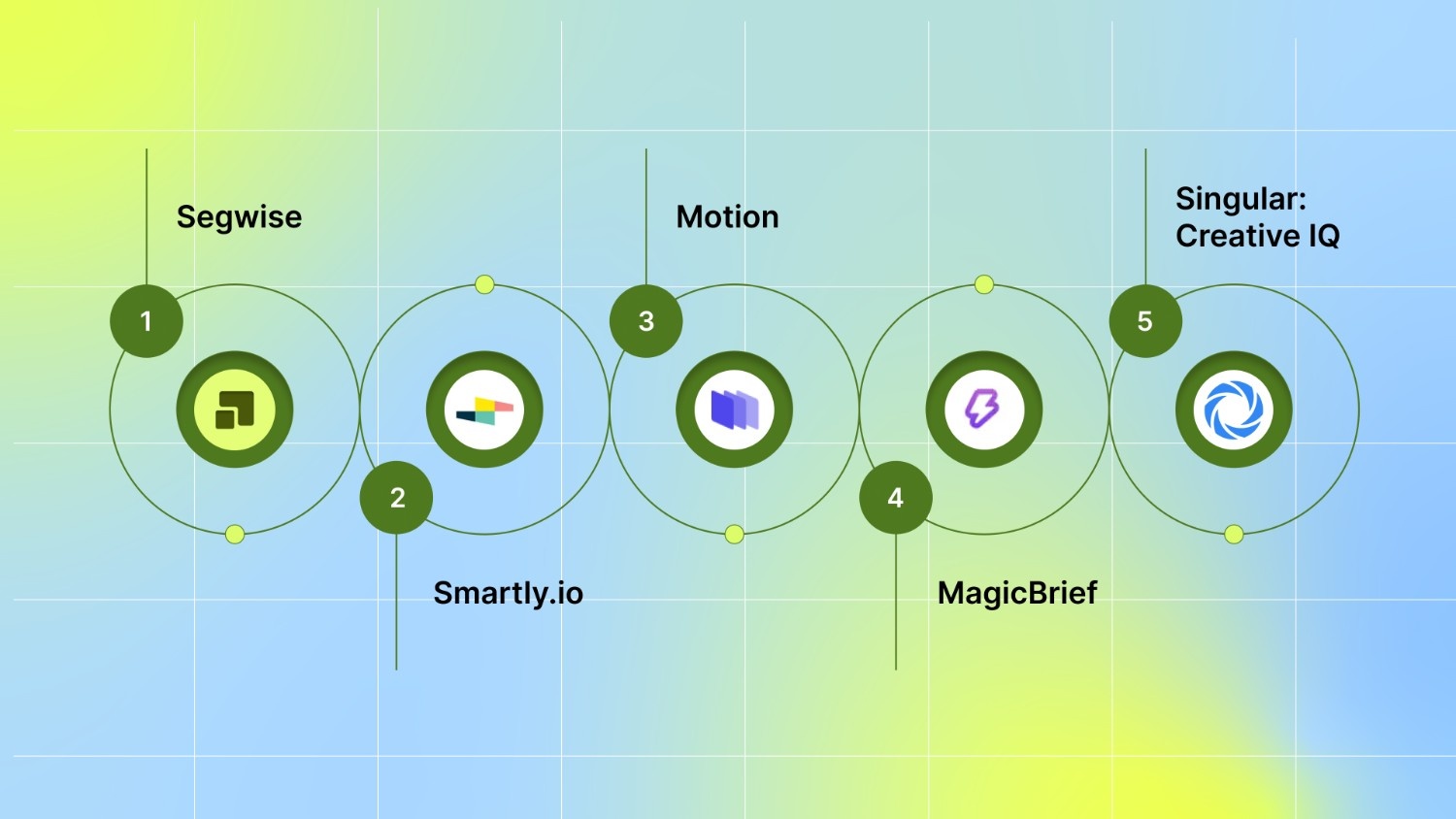
Finding the right creative optimization tools for DTC brands can transform how your brand acquires new users. From automated tagging to fatigue detection and visual reporting, these platforms help you scale what works and kill what doesn’t.
Here are five must-have tools designed to supercharge your new-user acquisition strategy:
1. Segwise
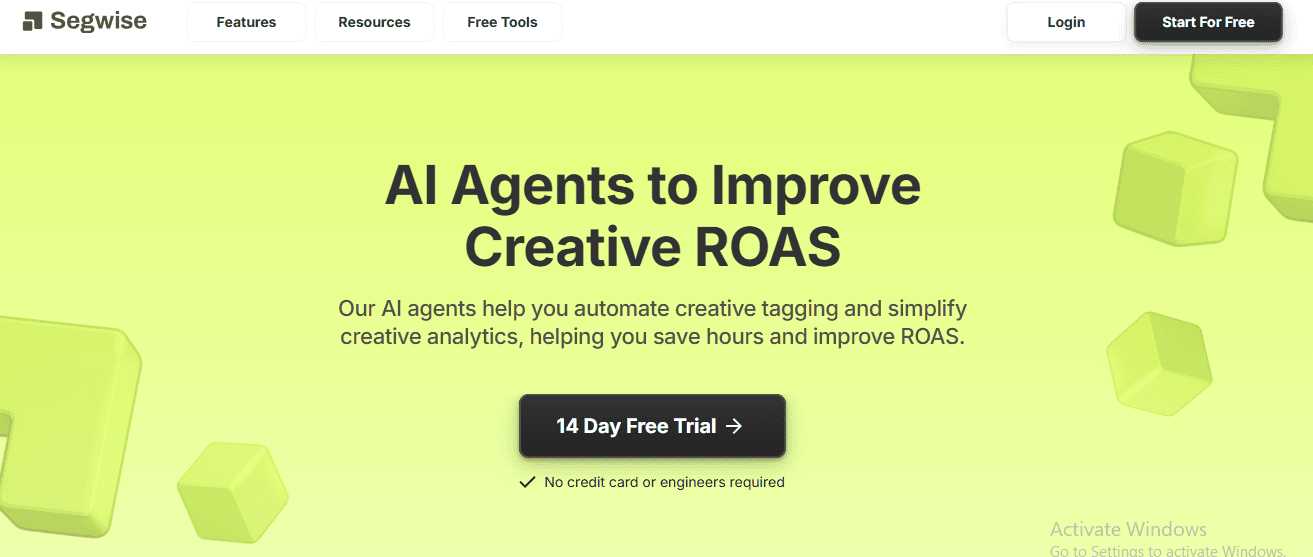
Segwise is an AI-driven creative analytics platform that auto-tags elements inside your ads (hooks, dialogue, visuals, audio) and correlates them with performance metrics like CTR, IPM, installs, and sign-ups across Meta, Google, TikTok, and more.
By unifying creative data and performance from major ad networks in one place, it reveals which specific elements and themes actually pull in new users so you can scale winners faster.
Key Features
AI Creative Tagging: Automatically labels images, videos, text, and playables, eliminating the need for manual tagging or spreadsheets. Use tag-level insights to see which scenes, hooks, and overlays correlate with first-time clicks and installs.
Creative Analytics: Combine creative-level data from all major ad networks into one view to understand why certain ads win cold audiences. Make iteration decisions with tag-level performance breakdowns instead of guesswork.
Competitor Tracking (coming soon):Monitor competitor creatives across Facebook, Google, and TikTok, spot patterns, and identify gaps. Segwise also offers a free Meta Ad Library tracker to follow up to five competitors.
Free tools for faster iteration: Convert MP4 video to playable HTML embeds for AppLovin and Mintegral playable inventory in minutes without any code using Segwise’s free video-to-playable converter.
Pricing
Start with a free trial, no engineering or credit card required. Paid plans are available after the trial; contact Segwise for details.
Who Is It Best For
Segwise is built for DTC growth teams, UA managers, and founders who are tired of chasing performance insights across fragmented dashboards and guessing which creative is truly driving results.
If you’ve ever struggled with:
Rising acquisition costs and no clarity on why performance dropped;
Manual tagging and inconsistent reports that slow creative decisions;
Creative fatigue that eats budget before teams can react; or
Disconnected metrics across Meta, Google, and TikTok
Then Segwise gives you the control and visibility you’ve been missing.
It unifies creative and performance data in one place, automatically connects creative elements to metrics like CTR, IPM, and ROAS, and alerts you to fatigue or declining trends before they impact results.
For growth-focused brands that want to scale faster without adding more tools or complexity, Segwise becomes the single source of truth for what works, and why.
2. Smartly.io
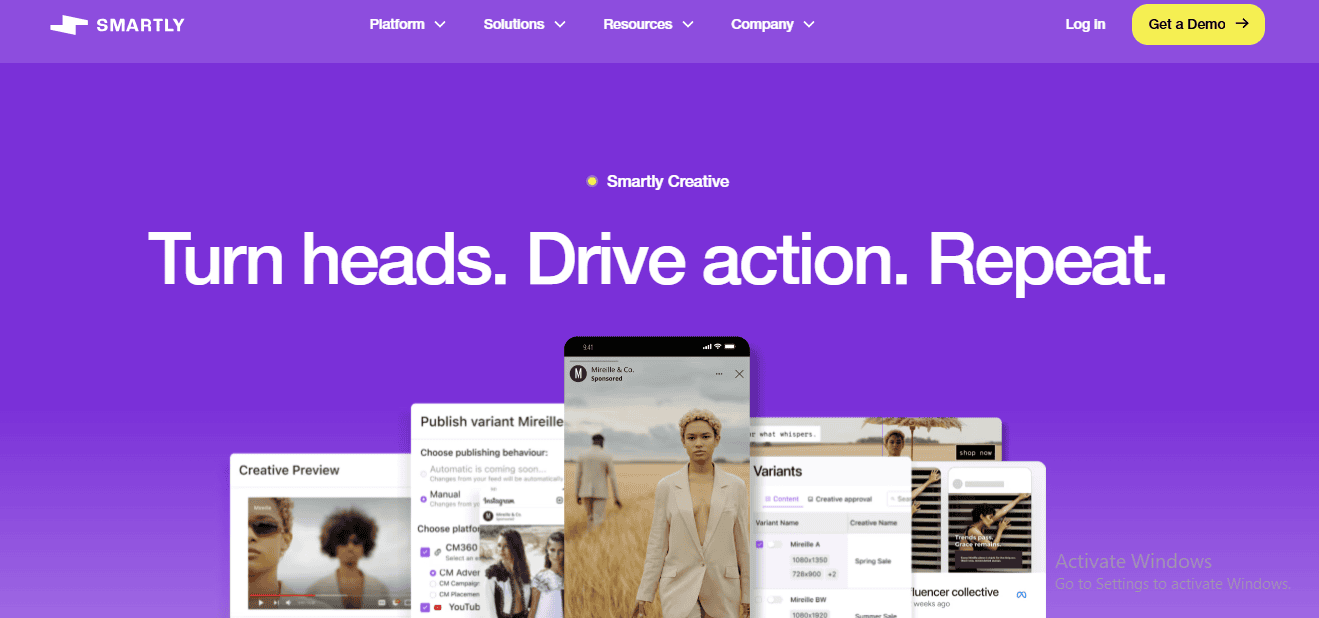
Smartly.io blends AI-assisted image/video/text editing with dynamic templates and real-time analytics across social, programmatic, and CTV, helping teams spin up and update prospecting creatives at scale. In practice, this involves transforming a single concept into multiple high-impact variants (UGC clips, rapid demo loops, comparison layouts) and optimizing them efficiently to reach new audiences.
Key Features
Dynamic templates & DCO: Smartly allows you to create dynamic, AI-powered image and video templates. Once a template is set, it can automatically generate thousands of personalized variants tailored by region, language, or demographic. The Dynamic Creative Optimization (DCO) engine localizes and adapts creatives directly from your product feeds or data sources
Creative Insights: The suite includes AI-powered Creative Insights that uncover what works with AI-powered analysis, identify top-performing elements, rank creatives by your KPIs, and spot the themes that drive engagement.
Pre-flight predictors: Before launching your ads, the platform offers pre-flight predictive insights, including heatmaps, attention scores, and decay curves, that forecast performance and user attention. These allow you to refine your creative in advance and increase the chances of success.
Pricing
Custom/enterprise pricing; request a demo to scope your setup.
Who Is It Best For
Smartly.io works best for large retail and enterprise marketing teams managing multi-country campaigns and needing heavy automation for creative production and feed-based personalization.
It’s ideal if your focus is scaling dynamic templates or localizing creatives across dozens of markets rather than analyzing creative performance in depth.
For smaller DTC or mobile-app teams, however, its setup complexity and enterprise-level pricing can make it impractical for day-to-day creative optimization.
It excels in automation, but teams looking for creative-element-level insights or ROAS correlation may find its reporting limited for actionable decision-making.
3. Motion
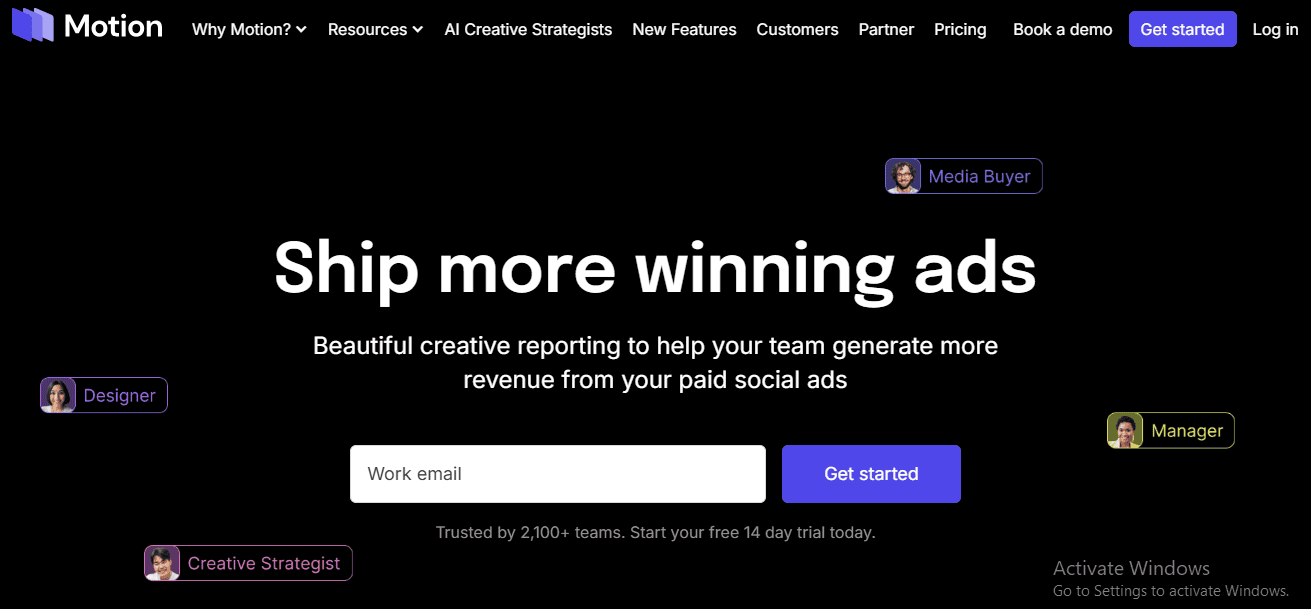
Motion is a creative analytics workspace for paid social that turns scattered ad data into clear, visual reporting. Its AI Tagging automatically analyzes Meta creatives (processed daily; requires spending in the last 90 days) and applies tags in four categories: Visual, Persona, Messaging, and Hook. This allows teams to spot patterns without manual labels.
Key Features
Visual reporting & ad grouping: Motion produces visual performance reports and groups ads by shared attributes; AI tags surface in reports and dashboards to highlight performance drivers.
Tagging & leaderboard: AI tags are applied automatically (no custom tagging), and Motion includes a weekly leaderboard that surfaces top-performing ads; eight comparative reports are auto-added after tagging.
Attribution integrations: Creative Analytics Pro supports integrations such as Northbeam and Google Analytics.
Pricing
14-day free trial ("Free AI Creative Strategist"): Includes Motion’s AI Creative Strategist tools, access to expert AI strategists from the Motion Marketplace, unlimited users, a Meta ad account integration, one workspace, and an ad leaderboard.
Paid "Creative Analytics" (starts at $250/month): Adds advanced creative reporting, custom tagging, unlimited workspaces and ad accounts, attribution integrations (Northbeam, Google Analytics).
Who Is It Best For
Motion is a good fit for creative teams and paid-social strategists who want visual performance dashboards and ad grouping features without deep data integrations.
It provides a clean creative reporting layer, making it handy for agencies or designers who need to communicate performance trends to clients.
However, it offers limited cross-network visibility and depends heavily on connected ad accounts for insights, which may not serve data-driven UA teams needing unified KPIs like IPM, CTR, and ROAS in one place.
It’s best suited for smaller creative teams focused on presentation rather than full-funnel optimization.
4. MagicBrief
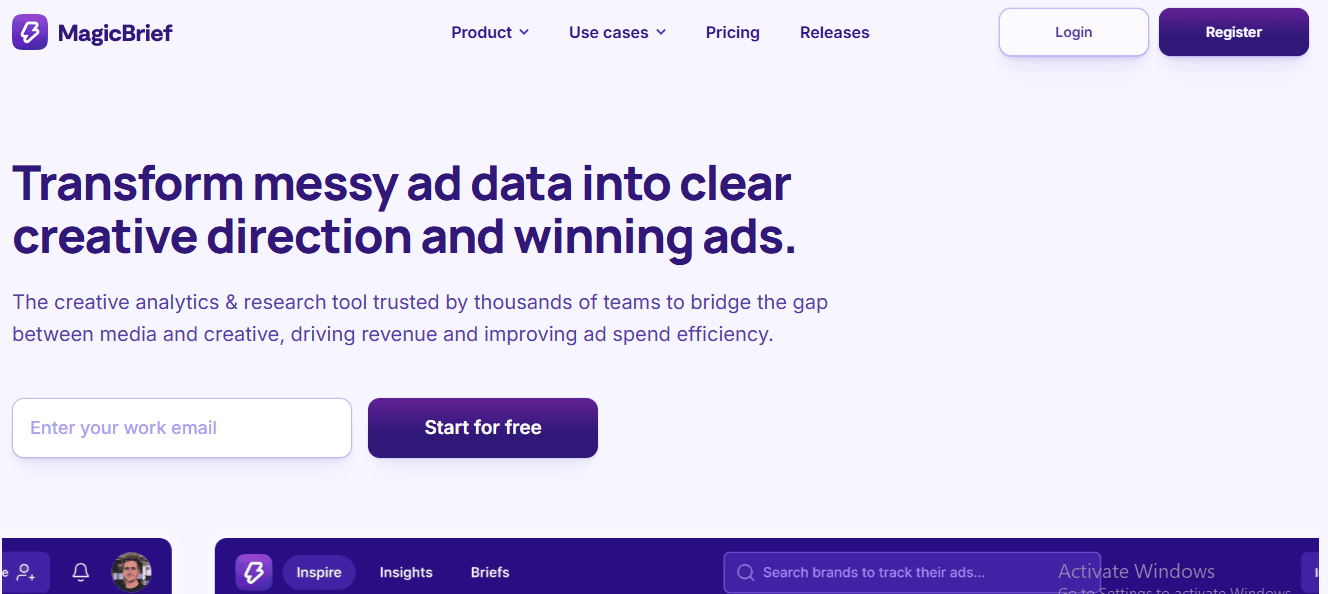
MagicBrief combines creative research and analytics to turn messy ad data into clear creative direction. You get a large curated ad inspiration library, plus reporting and an AI Copilot, so brands and agencies can test more ideas, faster, for new-user acquisition.
Key Features
Advanced creative reporting: MagicBrief offers in-depth creative analytics by syncing ad account data, transforming complex ad performance into clear, visual reports that reveal which creative elements are working and why.
AI copilot recommendations for next variants: Copilot monitors performance against custom benchmarks and suggests which ads to scale or cut, guiding your next iterations.
Slack integration: Built-in Slack integration enables automated reporting summaries, competitor activity alerts, and faster feedback loops, keeping the team in the loop without switching tools.
Pricing
Pro Plan (starts at $249/month, ad-spend based): Includes custom tracked brands, custom seats, custom ad account connections, lifetime platform data, advanced creative reporting, AI copilot recommendations, a modular creative brief builder, access to the world’s largest curated ad inspiration library, and Slack integration.
Creative Intelligence Plan (custom pricing; invite to chat): Offers everything in the Pro Plan, plus unlimited tracked brands, unlimited seats, unlimited ad account connections, personalized onboarding, a dedicated customer success manager (CSM), billing via invoice, and full access to the Creative Intelligence platform.
Who Is It Best For
MagicBrief is tailored for creative directors, agencies, and content teams who prioritize inspiration and collaboration over granular performance tracking.
Its large ad-inspiration library and Slack integration make it a strong brainstorming companion, helping teams organize and share ideas.
But it focuses mainly on surface-level metrics and aesthetic comparison, not on linking creative elements to measurable growth outcomes.
Teams seeking data-backed iteration or fatigue detection may outgrow it quickly once campaign volume scales, as advanced analytics and integrations require high-tier plans that can be expensive for smaller DTC brands.
5. Singular: Creative IQ
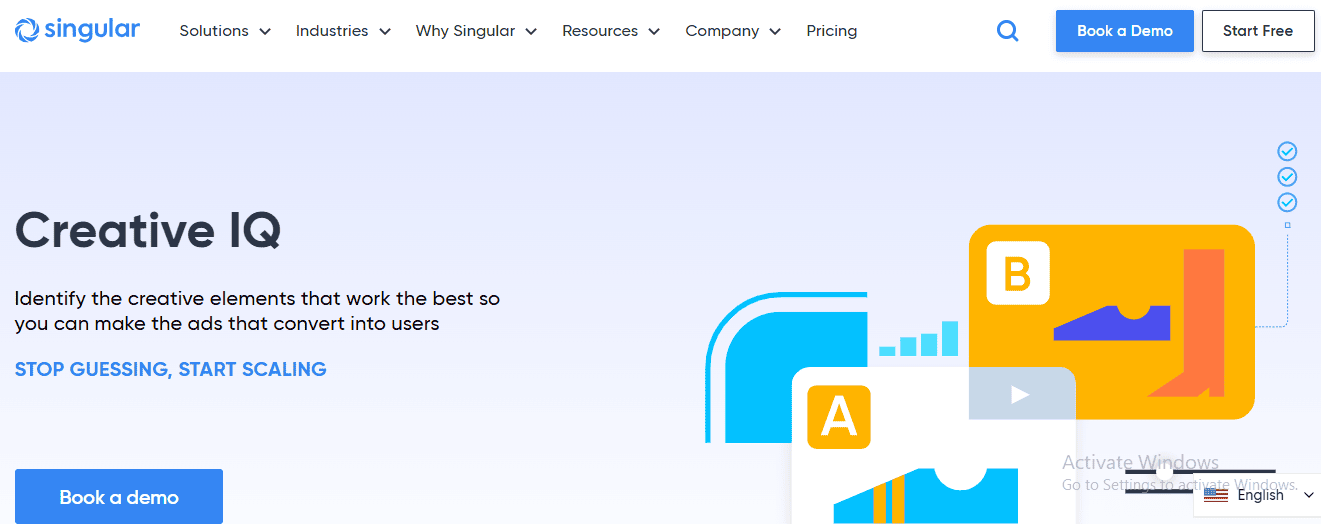
Creative IQ layers AI tagging and a gallery view on top of Singular’s measurement stack, linking specific creative elements directly to installs and down-funnel actions. You can cluster “same creatives,” slice by audience/theme/format, and quickly learn whether UGC vs polished demos, benefit overlays, or social-proof carousels are driving first-time users, then brief the next iteration with confidence.
Key Features
Visual reporting: Creative IQ displays your ad visuals, such as videos and images, alongside performance metrics like ROI, installs, and impressions, enabling quick and intuitive creative-performance comparisons.
Creative clustering: The platform offers a “Creative Gallery,” a visual interface that displays all creatives in one place, and employs AI-powered clustering to automatically group similar assets, helping you spot trends and patterns swiftly.
Cross-channel visibility: Creative IQ unifies creative and performance data across multiple ad networks (e.g., Google, Meta, TikTok), giving you a normalized, holistic view of how each asset performs across channels.
Pricing
Free plan ($0 / conversion): Includes 15,000 paid conversions, mobile attribution, ROI analytics, fraud prevention, tracking across email/SMS/social campaigns, deep linking, SKAdNetwork attribution, APIs, plus unique perks like SKAdNetwork cohort prediction, customizable dashboards, and creative reporting.
Growth plan ($0.05 / conversion): Includes everything in the Free plan, plus added benefits such as technical support, a customer experience team, 1-on-1 solutions-engineer onboarding, optional add-ons like no-code ETL exports, and more.
Enterprise plan (custom pricing): Includes everything in Growth, plus a dedicated customer success manager, enterprise-grade SLA, cross-device attribution, 365-day cohort analytics, audience management, advanced user permission controls, single sign-on (SSO), and an optional private cloud environment.
Who Is It Best For
Creative IQ is best suited for data analysts and enterprise-level marketing teams already using Singular’s attribution and measurement stack. Its strength lies in combining creative data with attribution pipelines for organizations that need deep cohort analysis and fraud detection.
However, for creative or UA teams without internal data engineers, setup can be complex and costly, and insights tend to favor attribution accuracy over creative iteration speed.
It’s most valuable for companies that already invest in a full measurement ecosystem and less practical for lean DTC teams seeking fast creative learnings without heavy infrastructure.
Also Read: Creative Optimization in 2025: Dynamic Creative Optimization (DCO) Playbook for Mobile UA
Conclusion
Creative optimization tools have become essential for DTC brands focused on acquiring new users. These platforms help you identify which creatives actually drive more clicks, installs, and sign-ups. With features like automated tagging, fatigue detection, creative clustering, and test reporting, you can iterate faster, avoid performance drops, and consistently scale prospecting campaigns with confidence.
But if you want to move beyond isolated insights and build a system that shows exactly why your best ads work, and how to scale them, Segwise is your answer.
It’s the only creative analytics platform that unifies performance data across networks, automatically tags and analyzes every element in your ads, and connects those insights directly to metrics that matter: CTR, IPM, ROAS, and LTV.
Segwise helps growth teams cut through noise, spot winning creative patterns before others do, and scale with precision instead of guesswork.
Start your free trial with Segwise and turn creative analytics into your acquisition advantage.
FAQs
1. Which creative elements usually drive more new users for DTC?
Short, platform-native videos with a clear hook in the first 3 seconds, on-screen captions, and a strong CTA tend to win. UGC-style spots, rapid demo loops, and benefit-first frames align with TikTok/short-form best practices for stopping the scroll and earning clicks.
2. How often should I refresh creatives to avoid fatigue in prospecting?
Watch for rising frequency and falling engagement; when performance dips, rotate new variants. Meta defines creative fatigue as overexposure to the same asset, and TikTok also advises refreshing regularly to keep results flowing.
3. Should we use A/B or multivariate tests for creatives?
Start with clean A/B tests to isolate one variable (hook line, opening shot, CTA) and get directional read fast; scale into multivariate once you’ve found a winning base. Meta’s guidance favors controlled A/B comparisons for reliable decisions.

Comments
Your comment has been submitted successfully!